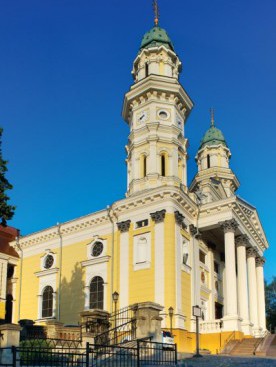The Greek Catholic Cathedral –UzhhorodGyörgy Drugeth of Homonna established in 1615 a Jesuit high school in Homonna. His son, János Drugeth, relocated the institution from Homonna to Uzhhorod in 1640. The Jesuit monastery was badly damaged at the end of the 17th century, during the anti-Habsburg wars, and the Jesuits left Ungvár on repeated occasions. The high school resumed its activities in 1718. We do not have information on the first church. The building of the second, extant, church began in 1732 and was finished in 1740. The church has an elongated layout with the sanctuary ending in a straight line and being connected to sacristies on both sides. Oratories have been built on the second level, above the sacristies. Both the nave and the sacristy are covered by groin vault ceilings, and three side chapels are connected to the nave on each side. Initially, the Greek Catholic bishopric of Munkács was established as a diocese under the legal jurisdiction of the Eger bishopric. Only Empress Maria Theresa was able to transform the Greek Catholic bishopric of Munkács into an independent diocese. The decision to move the seat of the bishop to Ungvár was made only after this event and, hence, the Jesuit monastery was transformed into the bishop’s palace, the church into a cathedral, while the fortress was given to the Greek Catholic seminary in 1775-1776. The inside of the Jesuit church was transformed according to the needs of the Byzantine rite, however its dedication – to the Holy Cross – remained unchanged. An altar with a baldachin, which allowed priests to walk around it, was brought to the sacristy. An iconostasis decorated with Rococo-style carvings was inserted into the chancel arch. The lower register of the latter is composed of four pictures and three gates, the next register shows the religious celebrations, the apostles and prophets, while the upper register Jesus Christ on the Golgotha. Three shrines holding relics are located above the royal gate, the middle one holding the Holy Cross. Andreas Tritina, an artist from Eperjes/Prešov (Slovakia), started painting the sacristy in 1777. After his demise, probably, Sebastian Hirschlinger finished the work in 1782. The shape of the pulpit is rather unusual: the speaker simply stands on a podium-like structure. The paintings on the backrests of the pulpit and the episcopal throne (the Apostle Saint Paul and Christ as High Priest, respectively) stem from 1789. The style of the main representations of the three altars is Baroque. One can see: in the middle chapel of the northern side the Crucifixion, in the side chapel next to the entrance on the northern side Saint Andrew and on the first altar on the southern side Saint John the Baptist. All major modifications were completed in 1780 and the cathedral was consecrated on the 15th of October 1780. The present, eclectic outlook is a result of modifications made in Baroque style in 1876-1877. |















